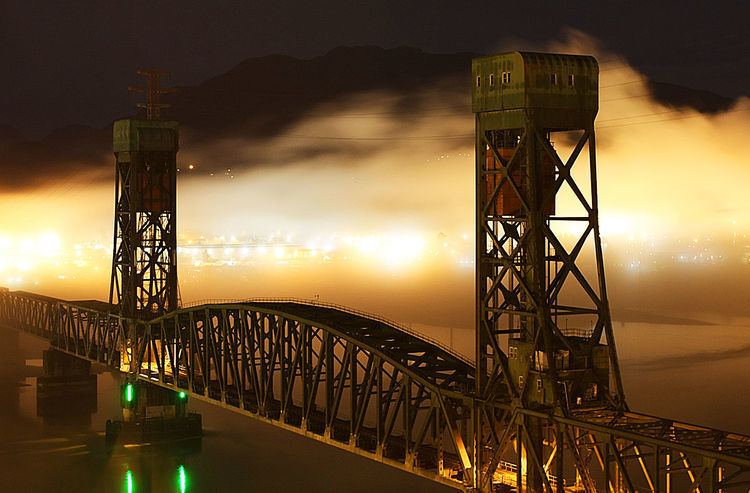Opened 1969 Province British Columbia | Bridge type Vertical-lift bridge | |
 | ||
Address Iron Workers Memorial Bridge, North Vancouver, BC, Canada Similar Lions Gate Bridge, Burrard Inlet, Pattullo Bridge, Indian Arm, Mount Seymour | ||
Second narrows bridge
The Second Narrows Rail Bridge is a vertical lift railway bridge that crosses the Burrard Inlet and connects Vancouver with the North Shore. As the name suggests, it is located at the second narrowing of the Burrard Inlet.
Contents
The original Second Narrows Bridge was constructed in 1925, and was the first bridge to connect Vancouver with the North Shore over the tidal bore of the narrows. This bridge was constructed, by John Stewart and Northern Construction, with a car deck and a year later in 1926 trains began using the bridge as well. After being hit by a number of ships and being out of service for 4 years, in 1933 the provincial government bought the bridge and installed a lift section of the deck.
In 1960 a new much larger (350 m, 1,150 ft, span) and higher 6 highway lane Second Narrows Bridge was completed alongside the original bridge, and the original bridge was converted exclusively for rail use. In 1994 the new road bridge was renamed the Ironworkers Memorial Second Narrows Crossing in honor of the ironworkers who died in accidents while building it. However, the new bridge is still commonly referred to as the Second Narrows Bridge.
The 1926 railbridge was replaced in 1969 by CN Rail with a larger, higher lift bridge. A bridgetender activates cables and counterweights to raise the span. Unless moving a train across the Burrard inlet, the lift section is always in the up position to allow ships to go underneath. The Lions' Gate Bridge spans the first narrows of Burrard Inlet.
The current CN Second Narrows railway bridge has a vertical clearance of 46 meter at the main lift span fully raised (open position). The vertical lift section of the Second Narrows Railway Bridge provides 137 meters clear navigation width between rubbing fenders. However, the Ironworkers Second Narrows road bridge has a vertical clearance of 44 meters and the shipping channel where the maximum vertical clearance is available is 110 metres wide.
Background
Amid the hullaballoo of the Klondike Gold Rush were schemes to build a railway from Vancouver to the Dawson gold fields. Of course the first stage in this would be to bridge Burrard Inlet and then build a railway north. John Hendry floated the Vancouver, Westminster, and Yukon Railway which built a line from Ladner to Westminster and then to Vancouver via Burnaby Lake. This line was paired with the Great Northern Railway who also wanted trackage into Vancouver.
In the process, various other railroads all became involved in the bridging scheme: the Canadian Northern Railway, Milwaukee Road, and the Pacific Great Eastern Railway. The bridge itself would be owned by the Federal Government as they had control of harbours and shipping, and would lease access to the railways as they did with the rail bridge in New Westminster. One of the main reasons was that there was very little space on the south shore for wharves, thus railways wanted to develop the North Shore. The south side was occupied by another railway. A company was floated, the Burrard Inlet Bridge and Tunnel Company, and contracts were issued to span the tidal bore. A one-point, a causeway was planned to dam the narrows and create bridges and wharves that way.
Alas, World War I intervened, as did the bankruptcy of all the interested railways. With it went dreams of the bridge and rails up Indian Arm, Capilano, or Howe Sound. However, the predecessor railways did sign contracts to build a bridge and a new Hotel Vancouver. Only after the war with huge increase in funding to improve harbours around the British Empire, partly due to problems associated with wartime shipping, did funds appear for the completion of the 1925 bridge. And so the north shore port became an amalgam of operations with Canadian National, Pacific Great Eastern and Harbour and Wharves Commission all using the bridge when it was not out of service. North Vancouver ferries operated at this time as well.
The essential wartime shipyards in North Vancouver underscored the need for reliable industrial access. Further, the expansion of Lynnterm, Wheat elevators, coal and the sulphur port in the 1960s indicated the growing use of the North Shore.
